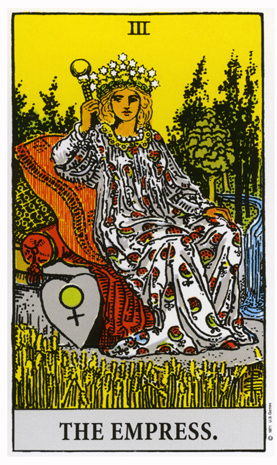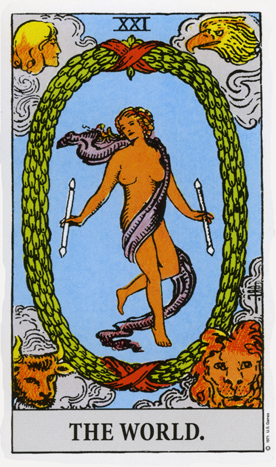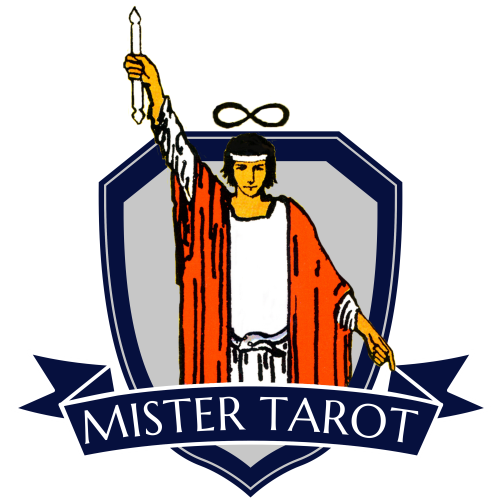Tarot is filled with images of beautiful women. One is draped in ritual robes, another is taming a lion, and many are naked! Who are the women of the Tarot and what do they represent?
When you first look at Tarot cards you might think they are just pretty pictures, but they are more than that. They contain symbolic designs that affect your subconscious mind whether you realise it or not. And Tarot cards feature images of Goddesses: the key players in the drama of the world’s myths and religions.
Let’s take a look at some of the main women of the Major Arcana: The High Priestess, The Empress, the maiden in Strength, Justice, The Star, and the dancing lady in the card called The World.
 The High Priestess: The character in this card is more of a girl than a woman. And her youth represents purity. She is robed in blue, a peaceful colour, so she has a clear mind. Behind her is a screen filled with images of pomegranates, which are the symbols of the Goddess Persephone. She sits at the entrance to the Temple of Solomon, with the book of Hebrew wisdom on her lap — and this represents she is a keeper of secret knowledge or special wisdom. This card’s essence is intuition and spirituality. She wears the crown of Isis, so she has links to Goddess energy. She is our introduction to the Tarot’s Feminine Divine.
The High Priestess: The character in this card is more of a girl than a woman. And her youth represents purity. She is robed in blue, a peaceful colour, so she has a clear mind. Behind her is a screen filled with images of pomegranates, which are the symbols of the Goddess Persephone. She sits at the entrance to the Temple of Solomon, with the book of Hebrew wisdom on her lap — and this represents she is a keeper of secret knowledge or special wisdom. This card’s essence is intuition and spirituality. She wears the crown of Isis, so she has links to Goddess energy. She is our introduction to the Tarot’s Feminine Divine.
The Empress: The very next card in the series represents manifestation. The Empress is earthiness and connectedness. She is voluptuous, sensual, and full-figured, with images of pomegranates on her dress. This time the pomegranates have their stems pointing down, so they form the symbol for female, which is also the sigil for Venus, as shown on her heart-shaped shield.
This shield is not a defensive shield, it’s more of a banner — something she can hold aloft and say, “This is who I am — I am woman of the earth — I am a Goddess!” Even behind the cushion, the abstract pattern is really a series of Venus symbols joined together. With this design A. E. Waite (designer of the modern Tarot) is saying that The Empress is not just giving an outer show of being a woman and a mother figure — every part of this card supports this idea and tells us she is all about comfort, softness, femininity and desire in its most loving form.
 The Empress can also be associated with the Greek Goddess called Demeter, with the symbols of this myth being the corn and pomegranates shown on the card. Demeter is a Goddess of fertility and agriculture. She is known as the Mother Goddess who held back the growth of crops when her daughter Persephone went missing.
The Empress can also be associated with the Greek Goddess called Demeter, with the symbols of this myth being the corn and pomegranates shown on the card. Demeter is a Goddess of fertility and agriculture. She is known as the Mother Goddess who held back the growth of crops when her daughter Persephone went missing.
The Empress is THE mother figure of the Tarot. She is the embodiment of creative energy. She is the mother figure who is kind and compassionate. She is the mother who holds you close when you are not feeling well; the one who protects you; the one who loves you despite your faults and failings. When you see The Empress card, think of her as a mother and all of these nurturing meanings will be seen in her.
Archetypes: The High Priestess and The Empress are archetypal images. An archetype is a symbol occurring in mythology, fairy tales, and religions. They are powerful symbols holding deep, meaningful qualities we can all associate with. Archetypes are as old as mankind. They are universal symbols or images that express concepts that affect us, and have meaning to us, even if we can’t put those feelings into words. They are primordial principles. All archetypal images are ingrained in our understanding even before we are old enough to think and reason. They are universal images; archetypes are found all over the world and all cultures resonate to them.
On the subject of archetypes,
Carl Jung said, “It is only possible to live the fullest life
when we are in harmony with these symbols;
wisdom is a return to them.”
Because Tarot is full of archetypal symbolism, when you find harmonic association with those main characters, wisdom is yours for the taking.

Strength: The maiden in the card called Strength is closing the lion’s mouth. The lion represents the primal beast in each of you — your physical or mundane urges and desires. The Strength card shows that even though women are seen as ‘the gentle sex’ with passive qualities, they have an inner strength. In their own gentle, quiet way they can overcome the greatest of difficulties. This is a card of courage, motivation, and a subtle power to be drawn upon whenever you need it.
Justice: You could be forgiven for wondering if this figure really is a woman; she has very short hair and a rather stern expression, quite unlike the feminine imagery usually associated with the women of the Tarot. However, the virtues are always portrayed in female form and this card is associated with Themis, the Goddess of Justice, so this is definitely a female image. Representing the concept of Justice as a seated woman with a sword and scales was a well-established device in religious art many centuries before the Tarot was invented. I assume that Waite and the artist Pamela Colman Smith portrayed Justice as a woman with masculine features because Justice is supposed to be equal to all. The image shows the fairness and equality implied by the meaning of this card; it reflects the concept of balance as represented by the scales.
The Star: This is another card featuring a Goddess. This is Ishtar, Queen of the Heavens, whose symbol is an eight pointed star. The woman is naked to represent freedom and natural expression. Waite calls The Star ‘The Great Mother’.
 The World: Finally, we come to the last card of the Major Arcana. In this image we see a female figure, draped in a violet sash, dancing in an oval wreath. This dancing figure is similar to the image of the Hindu God Shiva, whose dance of bliss is also a dance of death, representing both the creation and destruction of the universe. The white wands in the woman’s hands show she has the power to create her own reality. The purple sash signifies the attainment of spiritual wisdom. It’s a lovely way to end the sequence of cards known as The Major Arcana.
The World: Finally, we come to the last card of the Major Arcana. In this image we see a female figure, draped in a violet sash, dancing in an oval wreath. This dancing figure is similar to the image of the Hindu God Shiva, whose dance of bliss is also a dance of death, representing both the creation and destruction of the universe. The white wands in the woman’s hands show she has the power to create her own reality. The purple sash signifies the attainment of spiritual wisdom. It’s a lovely way to end the sequence of cards known as The Major Arcana.
Temperance? You may have expected me to include the card Temperance in this article, but this is an androgynous figure. This angel is neither male nor female, so it cannot be included.
The women of the Tarot are goddesses of the universe and they have a powerful, dynamic role within the deck. When they turn up in a reading, you are being blessed by their grace and creative energy.
